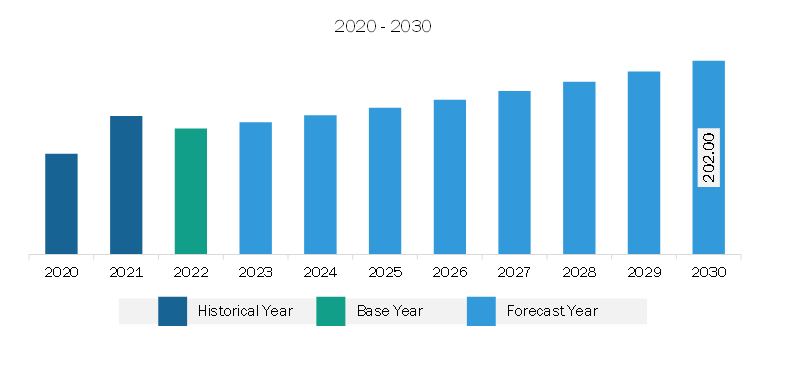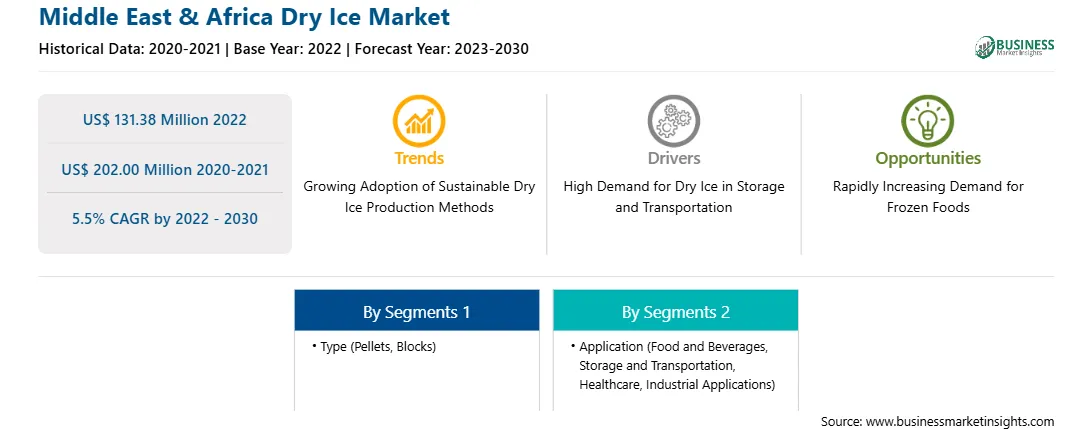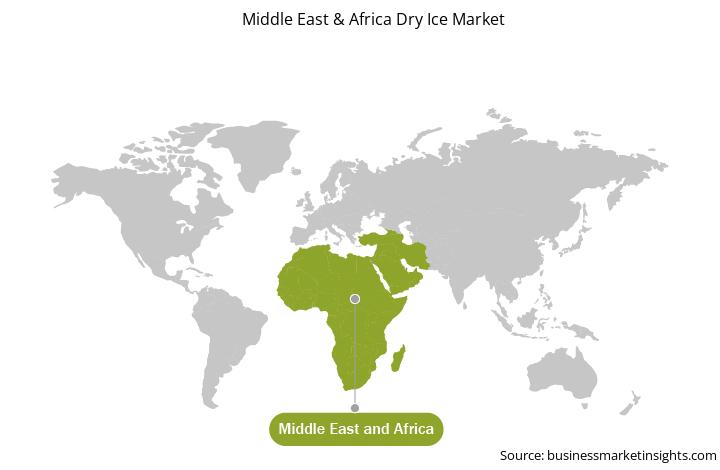The Middle East & Africa dry ice market was valued at US$ 131.38 million in 2022 and is expected to reach US$ 202.00 million by 2030; it is estimated to register a CAGR of 5.5% from 2022 to 2030.
Growing Adoption of Sustainable Dry Ice Production Methods Drives Middle East & Africa Dry Ice Market
Traditional dry ice production methods, which involve the direct capture of carbon dioxide from industrial processes, are energy-intensive and contribute to carbon emissions. However, the adoption of more sustainable practices is reshaping the industry landscape. Carbon dioxide from carbon-neutral sources is environmentally friendly, viable, and economically sustainable. Instead of using hydrocarbon by-products to capture carbon dioxide, a few dry ice producers are now using the anaerobic digestion process as an eco-friendly solution, and this trend is expected to gain traction during the forecast period. The biomethane produced by facilities integrating this new process is then captured and transmitted through gas upgraders, and eventually, membrane technology is utilized to separate carbon dioxide from methane.
Anaerobic digestion systems align with the circular economy concept by creating closed-loop systems. Organic waste inputs for anaerobic digestion can be sourced locally, reducing the need for transportation and supporting regional sustainability initiatives. This decentralized approach enhances the overall efficiency of the dry ice production process and minimizes the carbon footprint associated with the raw material acquisition.
Advancements in renewable energy sources are also influencing the sustainability of dry ice production. Incorporating renewable energy, such as solar and wind power, into the production process can significantly reduce the carbon footprints associated with dry ice manufacturing. Manufacturers adopting these sustainable energy practices are likely to gain a competitive edge in the market as environmentally conscious consumers and businesses seek eco-friendly alternatives. Thus, the increasing demand for anaerobic digestion systems and integration of renewable energy sources in dry ice production is a result of their ability to align with sustainability objectives, minimize environmental impact, and contribute to the circular economy. As industries prioritize greener practices, the integration of sustainable production processes into dry ice production processes is poised to become a key driver of growth in the sector.
Middle East & Africa Dry Ice Market Overview
The Middle East and Africa dry ice market is segmented into South Africa, Saudi Arabia, the UAE, and the Rest of Middle East & Africa. Strong economic growth in countries across the region is creating a platform for the development and expansion of the market in the region. The healthcare and pharmaceutical industry in the region is significantly growing, with governments in the region focusing more on the well-being of the increasing population. In addition, factors such as strong population growth, greater life expectancy, the predominance of lifestyle-related disorders such as diabetes, and demand for superior healthcare services are driving the pharmaceutical industry's growth in the region. Thus, the rising pharmaceutical industry in the Middle East & Africa is projected to drive the demand for dry ice in the coming years.
The climate in Middle Eastern countries is harsh as deserts surround them. Pharmaceutical shipments in these countries may get exposed to harsh weather conditions, causing severe damage to the products. Therefore, the companies take additional care in such regions to protect their shipments and avoid huge losses. This factor can also favor the dry ice market for pharmaceutical applications in the Middle East & Africa.
Further, the demand for frozen food products in the region is high. The region's frozen food product is witnessing rapid development with the growth of urban markets such as Dubai, Abu Dhabi, and Iran. New investment and better marketing strategies have led to the capture of market share in the Middle East & Africa. Moreover, according to the Food Export Association of the Midwest USA and Food Export USA–Northeast, in 2021, Saudi Arabia exported approx. US$ 1.1 billion of food products to the region, an increase of nearly 2% since 2020. The main products consisted of dairy items, processed foods, snack foods, processed dates, processed fruits & vegetables, sugar and sweeteners, and poultry meat. Demand for packaged foods is growing due to consumers' changing lifestyles and diets and the expansion of the food retail and food service sectors. The growing populations of the UAE, Bahrain, Saudi Arabia, Kuwait, Qatar, and Oman increased the demand for frozen products. This has been providing huge opportunities for the major players in the dry ice market. The food sector in the Middle East & Africa has experienced a sharp increase due to high economic growth, urbanization, population growth, and a rising middle class. Consumers highly prefer good quality food products with high nutritional value. The dry ice market offers lucrative opportunities to fulfill the growing consumer demands as it keeps frozen products contamination-free and improves their shelf life. All these factors are expected to create growth opportunities for dry ice market players in the Middle East & Africa.
Middle East & Africa Dry Ice Market Revenue and Forecast to 2030 (US$ Million)
Strategic insights for the Middle East & Africa Dry Ice provides data-driven analysis of the industry landscape, including current trends, key players, and regional nuances. These insights offer actionable recommendations, enabling readers to differentiate themselves from competitors by identifying untapped segments or developing unique value propositions. Leveraging data analytics, these insights help industry players anticipate the market shifts, whether investors, manufacturers, or other stakeholders. A future-oriented perspective is essential, helping stakeholders anticipate market shifts and position themselves for long-term success in this dynamic region. Ultimately, effective strategic insights empower readers to make informed decisions that drive profitability and achieve their business objectives within the market. The geographic scope of the Middle East & Africa Dry Ice refers to the specific areas in which a business operates and competes. Understanding local distinctions, such as diverse consumer preferences (e.g., demand for specific plug types or battery backup durations), varying economic conditions, and regulatory environments, is crucial for tailoring strategies to specific markets. Businesses can expand their reach by identifying underserved areas or adapting their offerings to meet local demands. A clear market focus allows for more effective resource allocation, targeted marketing campaigns, and better positioning against local competitors, ultimately driving growth in those targeted areas.
Middle East & Africa Dry Ice Strategic Insights

Middle East & Africa Dry Ice Report Scope
Report Attribute
Details
Market size in 2022
US$ 131.38 Million
Market Size by 2030
US$ 202.00 Million
Global CAGR (2022 - 2030)
5.5%
Historical Data
2020-2021
Forecast period
2023-2030
Segments Covered
By Type
By Application
Regions and Countries Covered
Middle East and Africa
Market leaders and key company profiles
Middle East & Africa Dry Ice Regional Insights

Middle East & Africa Dry Ice Market Segmentation
The Middle East & Africa dry ice market is categorized into type, application, and country.
Based on type, the Middle East & Africa dry ice market is segmented into pellets, blocks, and others. The blocks segment held the largest market share in 2022.
In terms of application, the Middle East & Africa dry ice market is segmented into food and beverages, storage and transportation, healthcare, industrial applications, and others. The storage and transportation held the largest market share in 2022.
By country, the Middle East & Africa dry ice market is segmented into South Africa, Saudi Arabia, the UAE, and the Rest of Middle East & Africa. The Rest of Middle East & Africa dominated the Middle East & Africa dry ice market share in 2022.
Gulf Cryo LLC, L’Air Liquide SA, Linde Plc, and SOL SpA are some of the leading companies operating in the Middle East & Africa dry ice market.
The Middle East & Africa Dry Ice Market is valued at US$ 131.38 Million in 2022, it is projected to reach US$ 202.00 Million by 2030.
As per our report Middle East & Africa Dry Ice Market, the market size is valued at US$ 131.38 Million in 2022, projecting it to reach US$ 202.00 Million by 2030. This translates to a CAGR of approximately 5.5% during the forecast period.
The Middle East & Africa Dry Ice Market report typically cover these key segments-
The historic period, base year, and forecast period can vary slightly depending on the specific market research report. However, for the Middle East & Africa Dry Ice Market report:
The Middle East & Africa Dry Ice Market is populated by several key players, each contributing to its growth and innovation. Some of the major players include:
The Middle East & Africa Dry Ice Market report is valuable for diverse stakeholders, including:
Essentially, anyone involved in or considering involvement in the Middle East & Africa Dry Ice Market value chain can benefit from the information contained in a comprehensive market report.